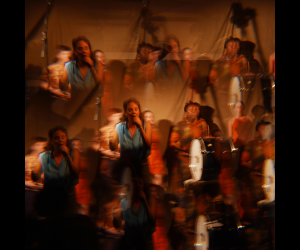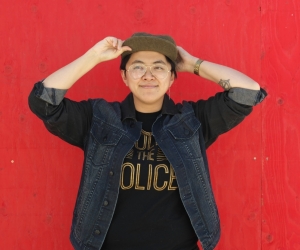
“Is being together possible?” The first words spoken in what we are saying, a sound–dance piece by the Toronto-based experimental performance company Public Recordings, have a disruptive effect—an abrupt imposition of language into an initially wordless and ambient sound environment, presenting the basis for what’s to come: a language-propelled choreography of sounds, bodies, objects, and ideas in a continual reckoning with the imminence of language both as sound and movement. The initial question is immediately followed by a chorus of simultaneous answers spoken from every direction, an improvised conversation in which performers attempt to listen and respond to each other simultaneously. What unfolds is a dance of utterance and a choreography of listening in which individual voices and perspectives become greater than the whole, offering listeners an opportunity to find new registers of meaning within an abundance of sound.
“Being together is impossible.” This statement follows quickly after the cacophony of responses to the initial question, but rather than being an answer, in the moment it feels like a second question in disguise, an intentional contradiction that sets off the paradox that makes this dance audible. Initiated by artist, choreographer, and Public Recordings associate artist Ame Henderson, what we are saying—which premiered in Toronto in 2013 and continues to be performed—is created and enacted by seven to eight artists. Over the years, casts have included dancers, actors, and visual artists. The nonfrontal performance takes place in an open space filled with chairs facing in every direction. Audience and performers occupy this perceptual zone together in the assumed passive position of sitting. Who is performer and who is audience is often ambiguous. Throughout the piece, performers emerge and move about, carrying microphones, cables, and small portable amplifiers from which their voices and other sounds issue. Slowly, they construct a fragile, rhizomatic amplification system that crisscrosses the room, while they collectively manipulate the loudspeakers and speak together in a leaderless attempted choral unison. They speak and sing without knowing what to say next. We hear curious questions and vulnerable answers. We hear the sounds of orchestras and soft tones of controlled feedback. We hear nonsense and bewilderment, laughter and held silence. We hear a group of people speaking about the world as they see it, trying to articulate how things could be different. We hear them speaking about the possibility and impossibility of truly being together.
This is not a work based in some romantic notion of a leaderless society—that caricature of twentieth-century Utopian socialism often projected onto the crowd gathered in the streets. Its idea of togetherness is different from the common notion of the collective as greater than the sum of its parts. Rather, the work’s particular vision of collectivity lies in the fragility, the weakness, of the crowd itself, whose greatest strength is its adaptability and easeful incorporation of the inputs and agendas of each individual. This is frequently misunderstood in relation to Occupy Wall Street (OWS), a movement that Henderson has said what we are saying is in dialogue with, especially regarding notions of decentralized control, networked spaces, and collective sounding in public space. The constant articulation of a noisy space—one that intentionally disrupts and reconfigures communication in pursuit of new kinds of communicative behaviours—is something OWS and what we are saying definitely have in common. The important point is that (non)communication spaces present the possibility of practising novel forms of togetherness that can eschew hierarchies, produce the unforeseen, and highlight a plurality of voices. OWS has shown us that continually holding an ambiguous networked space—one that privileges the flow of information and has no central organizational structure—offers a real, and (importantly) unstable information infrastructure which sets the stage for new forms of change-making—and, in the case of what we are saying, for new sounds to become audible. The search for productive instability (within a theatre, a concert, Zuccotti Park, an office, etc.) is also a search for new models of territory and togetherness. As Henderson points out, it has everything to do with listening.
“What we are working on with this piece, in a way, is to try to expand our perceptive capacity,” she explains in a recent conversation. “What I can track, in daily life for example, is a construction that, at best, allows me to feel okay, to survive. And this is fine, but maybe it is possible, and necessary, to override our habitual ways of ordering sensory data; to be in a reckoning with an abundance of information and to find new ways of drawing meaning from excess. I think being with excess—the kind of excess that cannot be quantified through habitual modes of assigning value—and trying to find your own way to pay attention, offers a moment to notice different registers of meaning: a moment of not knowing, of saying something that you didn’t know was possible, of hearing something that you may not even have the ability to understand.”
Voicing the unexpected is a regular occurrence throughout what we are saying. At one point, groups of three or four people break off from the crowd and begin to speak as one voice, attempting to ask a question without knowing what it will be. Another group responds and then in turn asks another question. As they do so, they try to find the words together through a hilarious and intuitive verbal stumbling, insisting on making what they have to say heard through the slow aggregation of a sentence, word by word, through consensus. Sonically, these strategies for speaking together bring to mind “the human microphone,” a vocal amplification tactic, also used by OWS, with those near to a public speaker repeating what is said en masse, thereby “amplifying” the speakers words and circumventing the need for permits, which are required in order to use audio amplification systems in public spaces. But what happens in what we are saying is not a smooth transmission of information from speaker to audience, but a dance of finding what needs to be said together in the moment, and an insistence on disrupting normative semantics at every turn. The effect is oddly musical, as the voices of many sound together in an intuitive, rhythmic unison.
The slippage between speaking and singing eventually leads to moments when the performers sing together a strange kind of improvised folk song. The sound is disarming and humorous, at times recalling American composer Robert Ashley’s well-known works exploring the musicality of speech. Music plays a crucial role in what we are saying: at certain times, nonvocal soundscapes disrupt in unexpected ways. Alexander MacSween, the sound designer on the project, noted in a recent conversation that music is another element in the work where practices of decentralizing control are performed. All the performers are responsible for producing and spatializing the audio, playing back prerecorded sounds, using live microphones, and applying subtle vocal effects to their voices. But there are several moments when music appears in the room seemingly from some outside force, and these moments take the work into an entirely different, exciting register. A rich multichannel soundscape, which emerges from all ten loudspeakers near the beginning of the piece, is a collection of tracks each composed in a different genre (techno, orchestral, folk, rock, etc.), the indeterminate combination of which MacSween describes as “culturally dislocated.” These tracks play out of synch with one another, creating a dense polyphony, and then slowly begin to converge harmonically into one single note, creating a prolonged moment akin to the experience of listening to an orchestra tuning. Later in the piece, a recording of children singing a playful Brazilian lullaby (“Nanderu Rimbàje” by Tenondé Porã) emerges unexpectedly from the loudspeakers and frames the performative moment quite happily as an uncanny folk dance. In these instances, music is a momentary infiltrator, a sonic body whose presence complicates our perception of inside and outside.
Like the transition in the piece from speaking to singing, dancing comes in and shifts language into another form. The performers are continually managing their physical relationships to each other, negotiating distances and the scale of connections between sounds and bodies. At one moment, they even begin to respond to and “ask questions” of each other only through physical movement. The body is clearly broadcasting a language of connectivity, but as words and semantics begin to fall away we are left with an experience that is different from speech. To describe it as transcending language oversimplifies it. What is happening is more like a continual spilling of language (language that is being found in the moment) into other forms of syntax (dance and music), a process that has more to do with immanence than transcendence. The dancing in what we are saying is administering the boundaries and connections of a network of sound, movement, and ideas, as well as articulating the “noise” that continually disrupts the communication paradigm of that network. This is what French philosopher Félix Guattari calls “asignifying semiotics.”
As Footprint Journal guest editors Deborah Hauptmann and Andrej Radman note in their introduction to the Spring 2014 issue, “Asignifying signs do not represent or refer to an already constituted dominant reality. Rather, they simulate and pre-produce a reality that is not yet there.”
There is a certain magical presence at work in what we are saying. Watching it, we feel as if we could sit there while the performers simply listen, and something unexpected and meaningful would inevitably make itself heard.
We are here together now, close to the end, and there is dancing. Some people in the audience shift perspective, moving to another chair. We hear quiet sounds from somewhere unknown. Someone crouches precariously on top of a chair. There is dancing all around. Movements are travelling between performers. The effect is intoxicating. There is a feeling that anything is possible, that we the audience might all get up and dance together with the performers, causing the whole piece to simply disappear. Then, just when the idea of participation emerges, a member of the audience stands up. Other performers see this and begin to dance, their decision to join in strong and decisive. Their actions are incorporated by the group with surprising smoothness. And then another person in the audience joins in, again with surprising ease. It is a bit unnerving. There is a feeling that the proximity between audience and performer is collapsing. But these new dancers, these infiltrators, know all the right moves. It seems that they’ve rehearsed this before, that they know the rules of engagement too well, that they know the dance, and the dance knows them. Are they really infiltrators? Or is this just an affectation, an image of participation, a representation of togetherness?
FYI: what we are saying is touring Ontario in late September and October 2016, with performances in North Bay, London, Guelph, Kingston, and Ottawa. Visit publicrecordings.org for more information.
Produced by Public Recordings, what we are saying was created by Frank Cox-O’Connell, Katie Ewald, Mairéad Filgate, Sherri Hay, Ame Henderson, Sandra Henderson, Brendan Jensen, Benjamin Kamino, Alexander MacSween, Liz Peterson, Kim Purtell, Nick Rose, Bojana Stancic, Stephen Thompson, and Evan Webber. It was coproduced by and presented at Dance4 (Nottingham), Festival TransAmériques (Montreal), and Harbourfront Centre World Stage in association with The Power Plant Contemporary Art Gallery (Toronto). It was developed in residencies at Dance4, OBORO (Montreal), and Gallery TPW (Toronto).
Photo: Members of Public Recordings (l to r: Sherri Hay, Katie Ewald, Ame Henderson, Mairéad Filgate) performing what we are saying at the Open Ears festival in Kitchener, Ontario, in May 2016. Photo by: Jeremy McCormick.


